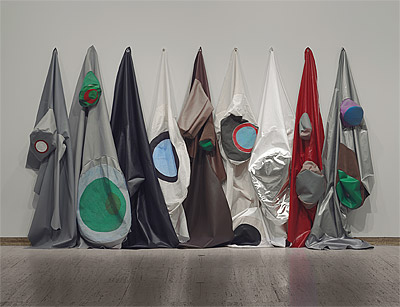Mikala
DWYER
Australia
1959
Hanging eyes from the series iffytown
1999
vinyl, canvas, synthetic polymer paint
dimensions variable
Art Gallery of New South Wales, Sydney
Gift of the artist 2002 129.2002A–I
© Mikala Dwyer. Licensed by VISCOPY, Australia.
Many soft sculptures or works which engage ideas of anthropomorphism draw our attention to the human body by its absence. In Hanging eyes 1999, from Mikala Dwyer’s four-part installation iffytown, the brightly coloured, disembodied vinyl forms hang like a series of coats on the wall.[1] It’s as if a group of slightly serious clowns have upped and left. Looking more closely at the bulbous inset shapes, we realise they actually have no relationship to hoods, sleeves or any other item of clothing. Then we become aware that the painted target-like circles disconcertingly resemble eyes.
Dwyer reconfigures or recombines her works for different showings, often to quite startling effect.[2] Her seemingly abstract sculpture and more directly representational works originate in her fascination with shelter, the home and urban structures, as Wayne Tunnicliffe and others point out.[3] As an installation, iffytown evokes an urban environment with built and organic forms, with Hanging eyes acting as ‘a sentinel for the overall enterprise’. If the multicoloured PVC pipes and other machine-like components of the installation resemble children’s blocks and other toys laid out for play on the floor, then the coat-like forms of Hanging eyes are the crowded, haphazard bags and wet-weather gear outside the classroom. Together each of the elements is either too big or too small to add up to an overall environment, making the whole process of interacting with Dwyer’s work like Alice in Wonderland on acid.[4]
Despite the element of play, Dwyer’s work is rarely naïve or unequivocal—this is a knowing sort of innocence.[5] Her cubby holes are neither utopias, nor defensive retreats, cocoons or fortresses.[6] Without the backdrop of a children’s playroom, or a chaotic teenage bedroom, the element of surveillance in Hanging eyes seems more menacing; taken individually, the combination of vinyl and painted shapes in each ‘costume’ resemble military colours. Hanging, empty, they are ghost-like; the anonymity offered by these capes is potentially more sinister still. Ku Klux Klansmen? This is an Oldenburg-like anthropomorphism, but of a much nastier type. La-la-la-la… it’s time to stop playing and go home.
Lucina Ward
Curator
International Painting and Sculpture
National Gallery of Australia, Canberra
[1] Hanging eyes and the other components of iffytown―Un, IOU and Iffytown―can be shown separately or together. All four works are in the collection of the Art Gallery of New South Wales, Sydney
[2] Dwyer has made a second version of the work, Hanging eyes 2 2000: vinyl, plastic, synthetic polymer paint on canvas, synthetic fur, felt, steel eyelets, 262.8 x 517 x 205.5 cm (installation), National Gallery of Victoria, Melbourne
[3] Wayne Tunnicliffe, 'Reality Bytes', Contemporary: Art Gallery of New South Wales Contemporary Collection, Art Gallery of New South Wales, Sydney, 2006, pp 400–01, at p 438
[4] Benjamin Genocchio, ‘Alchemy with a mischievous touch,’ The Australian, Friday 29 December 2001, p 10
[5] Elsewhere Dwyer has made mischievous, over-the-top accumulations of fabrics (from elderly blankets to tulle, organza and sequin-encrusted cloth), wool, modelling clay, acrylic, paint, stockings, ferns, rocks, and ordinary household items such as squash rackets or vacuum cleaners
[6] Edward Colless, ‘Undone’, in MikalaDwyer,Museum of Contemporary Art, Sydney, 2000, pp 12–13; Colless continues: ‘Their contours are either torn open or too pliant to contain or shield their occupants. There is too much traffic between the interiors of her forms and their exteriors for the difference to have any fundamental and consistent value’

